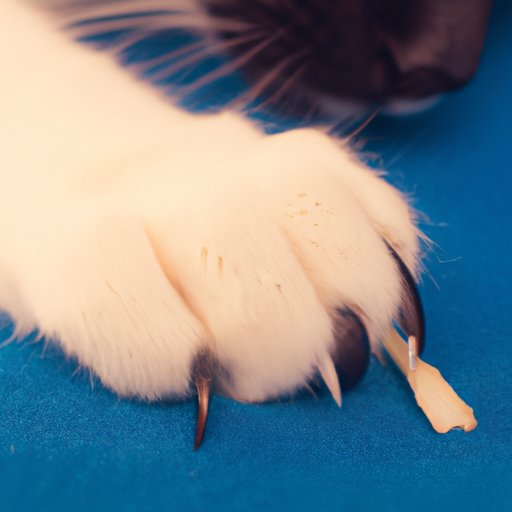
I. Introduction
As a cat owner, one of the important tasks is to keep your furry friend’s nails trimmed for their health and safety. However, most cat owners find it challenging to trim their cat’s nails due to the fear of injuring them or making them uncomfortable. In this article, we will provide a step-by-step guide on how to trim your cat’s nails and address various concerns around the process.
II. Step-by-Step Guide
Cutting a cat’s nails is not as difficult as it sounds. Here are the steps to follow:
Supplies Needed for Trimming Cat’s Nails
Gather all the necessary tools before starting nail trimming. You’ll need cat nail clippers, treats, and styptic powder to stop bleeding.
Proper Technique for Holding a Cat and Clipping Their Nails
It is essential to hold your cat correctly to prevent them from running away or getting injured. Hold your cat firmly, and ensure they are comfortable before the procedure.
Steps for Clipping Cat’s Nails
Clip the nails one by one, starting with the front legs. Avoid cutting the pink vein known as the quick, which can cause bleeding and pain.
Tips for Avoiding Injury to the Cat while Trimming Their Nails
It is essential to stay relaxed while trimming your cat’s nails and avoid rushing the process. Pushing the cat’s paw gently will extend the nail, making it easier to clip. If you’re unsure, seek professional help.
III. Choosing the Right Tools
Different Types of Tools for Trimming Cat’s Nails
Cat nail clippers come in different styles such as scissor or guillotine types. Choose a clipper that your cat is comfortable with.
Pros and Cons of Each Tool
The guillotine style clipper may be more comfortable for cat owners with large hands, while scissor clippers are better for precise trimming. Additionally, claw covers can be used to avoid trimming altogether.
How to Maintain and Clean the Tools
Regular cleaning and sharpening ensure that the tools remain safe and effective. Clean the tools in soapy water, let them dry, and store them in a safe place.
IV. Understanding Cat Behavior
Importance of Knowing Cat’s Behavior and Preferences for Nail Trimming
Trusting your cat and understanding their behavior can make trimming their nails a more comfortable process. Observe your cat’s personality for preferences on where they are comfortable and what may stress them.
Tips for Creating a Calm Environment for the Process
Choose a comfortable, quiet spot free of distractions. Calmly talk to the cat, so they feel at ease, and use treats before, during, and after the process.
Techniques for Soothing a Cat during the Process
Cats can get anxious during nail trimming, so it is essential to make them relaxed by soft, slow movements and avoiding loud sounds. Give them breaks in between clips, and praise for good behavior.
V. Trimming Frequency
Explanation of How Often Nails Need to Be Trimmed
It’s best to trim your cat’s nails at least once every two weeks to maintain the length and prevent them from growing too long. Keep an eye out for signs of overgrowth, such as curling or clicking noises when walking
Risks of Not Trimming a Cat’s Nails
If a cat’s nails become too long, they can break easily, leading to pain, infection, or limb deformity. Overgrown nails can also snag on carpeting and furniture, causing damage to both.
Health Benefits of Keeping a Cat’s Nails Trimmed
The benefits of trimming your cat’s nails include reducing the risk of injury, keeping them healthy, and promoting good hygiene. Additionally, trimming their nails can promote physical and mental health.
VI. Preparing for the Process
Tips for Preparing a Cat for Nail Trimming
Cat owners should prepare their furry friends for trimming by getting them used to handling their paws months in advance. Teach them to associate physical touch with positive stimuli to ease the process.
How to Introduce the Tools to a Cat
Before starting to trim, let your cat familiarize themselves with the tools and their sounds. Reward them for exploring the tools when introduced to them for the first time.
Techniques for Creating a Comfortable Environment
Creating a conducive environment involves keeping away loud noises or other pets that could cause stress. Dim light and comfortable temperature can also aid relaxation.
VII. Troubleshooting Common Problems
Common Problems That Can Arise during the Nail Trimming Process
Common problems include accidentally cutting the quick, cat scratching, and uncooperativeness during the trimming process.
Solutions for How to Deal with Them
These problems can be solved by maintaining a calm environment, seeking professional help, and training your cat to trust the process.
When to Seek Professional Help
If you’re unsure about trimming your cat’s nails or have trouble controlling them, seek professional help. Veterinary clinics and professional groomers can assist in nail trimming.
VIII. Alternatives to Traditional Nail Clipping
Explanation of Alternative Methods for Keeping a Cat’s Nails Trimmed
Cat owners can choose alternative methods such as using scratchers or providing rough surfaces. Additionally, claw caps can be used to cover the nails entirely.
Pros and Cons of Different Methods
Each method has its pros and cons. Claw covers provide a humane way of trimming nails, while scratchers keep the cat active and happy.
Combination of Methods for Optimal Results
A combination of methods can be used for optimal results. Using claw covers and scratching posts can help keep the cat healthy and happy.
IX. Conclusion
Trimming your cat’s nails can seem like a daunting task, but it is an essential process. With a little patience and the right tools, the experience can be enjoyable for both the cat and the owner. Keep your cat healthy and relaxed by following the guidelines provided in this article at least every two weeks.
Final Tips: Always start with praise and treats; be firm yet gentle when holding your cat; observe safety by avoiding cutting the quick, and clean and store the tools safely.




